Cystopteris protrusa (Southern Fragile Fern)
| Also known as: | Lowland Bladder Fern, Southern Bladder Fern, Protruding Fragile Fern |
|---|---|
| Genus: | Cystopteris |
| Family: | Dryopteridaceae (Wood Fern) |
| Life cycle: | perennial |
| Origin: | native |
| Habitat: | part shade, shade; average to moist soil; rich forest, wooded slopes, stream and river banks |
| Fruiting season: | late spring to mid-summer |
| Plant height: | 4 to 14 inches |
| Wetland Indicator Status: | GP: FACW MW: FACW NCNE: FACU |
| MN county distribution (click map to enlarge): |  |
| National distribution (click map to enlarge): |  |
Pick an image for a larger view. See the glossary for icon descriptions.
Detailed Information
Fiddlehead:
![[photo of fiddlehead]](/udata/r9ndp23q/pd3/cystopteris-protrusa-042217-2-t.jpg) Fiddleheads emerge in spring on green stems sparsely covered in tan scales.
Fiddleheads emerge in spring on green stems sparsely covered in tan scales.
Leaves and stems: 

![[leaf scan]](/udata/r9ndp23q/pd3/cystopteris-protrusa-073115_0003-t.jpg) Leaves (fronds) are compound, 3 to 14 inches long, up to 4 inches wide, with 6 to 12 pairs of branches (pinnae) that are alternate to more or less opposite and generally perpendicular to the stem. The frond is widest at or a little below the middle, the lowest pinnae pair usually noticeably shorter than the second lowest. Pinnae are lance-oblong to triangular in outline, tapering to a pointed tip, mostly short-stalked, the largest pinnae with 5 or more pairs of lobes or leaflets (pinnules).
Leaves (fronds) are compound, 3 to 14 inches long, up to 4 inches wide, with 6 to 12 pairs of branches (pinnae) that are alternate to more or less opposite and generally perpendicular to the stem. The frond is widest at or a little below the middle, the lowest pinnae pair usually noticeably shorter than the second lowest. Pinnae are lance-oblong to triangular in outline, tapering to a pointed tip, mostly short-stalked, the largest pinnae with 5 or more pairs of lobes or leaflets (pinnules).
![[photo of pinnule veins]](/udata/r9ndp23q/pd3/cystopteris-protrusa-15-s12-t.jpg) Pinnules are irregularly toothed and smooth on both surfaces, lacking any hairs, glands or scales. Pinnule veins are branched, sometimes forked, and usually terminate at the tip of a tooth or lobe, though there may be a minute indentation where the vein terminates. The pinnules nearest the stem on the lowest 1 or 2 pinnae pair are often wedge-shaped at the base, tapering to a short stalk .5 to 1 mm long.
Pinnules are irregularly toothed and smooth on both surfaces, lacking any hairs, glands or scales. Pinnule veins are branched, sometimes forked, and usually terminate at the tip of a tooth or lobe, though there may be a minute indentation where the vein terminates. The pinnules nearest the stem on the lowest 1 or 2 pinnae pair are often wedge-shaped at the base, tapering to a short stalk .5 to 1 mm long.
![[photo of stem bases and protruding rhizome]](/udata/r9ndp23q/pd3/cystopteris-protrusa-052517-8-t.jpg) Stems are grooved, have a few scattered tan scales below the leaf, and are commonly straw-colored to greenish throughout except sometimes darker brown at the very base. The plant grows in an asymmetrical clump, the fronds erect to ascending to arching. The rhizome (underground stem) is covered in yellowish hairs and extends 1 to 5 cm (to 2 inches) past the clump of fronds. Old stem bases persist, and colonies may form from the long, creeping rhizome.
Stems are grooved, have a few scattered tan scales below the leaf, and are commonly straw-colored to greenish throughout except sometimes darker brown at the very base. The plant grows in an asymmetrical clump, the fronds erect to ascending to arching. The rhizome (underground stem) is covered in yellowish hairs and extends 1 to 5 cm (to 2 inches) past the clump of fronds. Old stem bases persist, and colonies may form from the long, creeping rhizome.
Spores: 
![[photo of sori]](/udata/r9ndp23q/pd3/cystopteris-protrusa-15-s19-t.jpg) The sori (group of spores) mature starting in late spring and are found on the underside of the leaf. They are circular and arranged in a row along one or both sides of the pinnule midvein about halfway to the pinnule edge. An egg to cup-shaped, translucent tissue (indusium) partly covers the spores and is attached on inner curve but usually withers away as spores mature. Spores ripen to dark brown or black. Not all leaves have spores. The earliest fronds are sterile, smaller and less finely divided with rounder teeth than later fronds, which are mostly fertile.
The sori (group of spores) mature starting in late spring and are found on the underside of the leaf. They are circular and arranged in a row along one or both sides of the pinnule midvein about halfway to the pinnule edge. An egg to cup-shaped, translucent tissue (indusium) partly covers the spores and is attached on inner curve but usually withers away as spores mature. Spores ripen to dark brown or black. Not all leaves have spores. The earliest fronds are sterile, smaller and less finely divided with rounder teeth than later fronds, which are mostly fertile.
Notes:
Southern Fragile Fern is uncommon in Minnesota, where it reaches the northern edge of its range, found on the forest floor in moist, rich woods and not on rocks. The rhizome is its most distinctive feature; the yellowish hairs and the extension slightly beyond the clump of fronds are unique characteristics. The rhizome is not buried very deeply so with a little care it might be located without digging a whole plant up (we dug ours from our garden).
Otherwise, C. protrusa is not easily distinguished from the related C. fragilis and C. tenuis, both of which also lack any hairs, glands or scales on the pinnules or upper stem, but both grow on rocks (or thin soil over rock). C. tenuis may also grow in soil and its pinnae tend to be more angled towards the frond tip than perpendicular to the stem, but not always obviously so. The pinnules closest to the stem on the lowest pinnae of these three species might be distinctive, with C. tenuis usually having stalkless pinnules, C. protrusa usually stalks .5 to 1 mm long, and C. fragilis stalkless or stalks up to .5 mm. This trait is variable so it alone should not be a determining factor.
The remaining Cystopteris species in MN, C. bulbifera, C. laurentiana and C. tennesseensis, all have at least sparse glandular hairs and bulblets on the upper stem and back side of pinnules, though bulblets on the latter two are few and misshapen.
Native Plant Nurseries, Restoration and Landscaping Services ↓
More photos
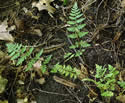 Cystopteris protrusa plant
Cystopteris protrusa plant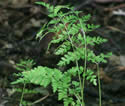 Cystopteris protrusa plant
Cystopteris protrusa plant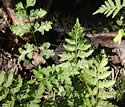 Cystopteris protrusa plants
Cystopteris protrusa plants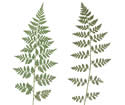 leaf scan
leaf scan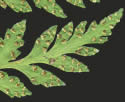 spore pattern
spore pattern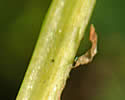 lower stem has sparse scales
lower stem has sparse scales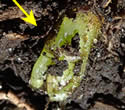 rhizome extension is buried just below the surface
rhizome extension is buried just below the surface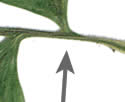 comparison of lowest pinnae on C. fragilis, C. protrusa, C. tenuis
comparison of lowest pinnae on C. fragilis, C. protrusa, C. tenuis
Photos by Peter M. Dziuk taken in Fillmore County and in his garden.
Comments
Have you seen this plant in Minnesota, or have any other comments about it?






